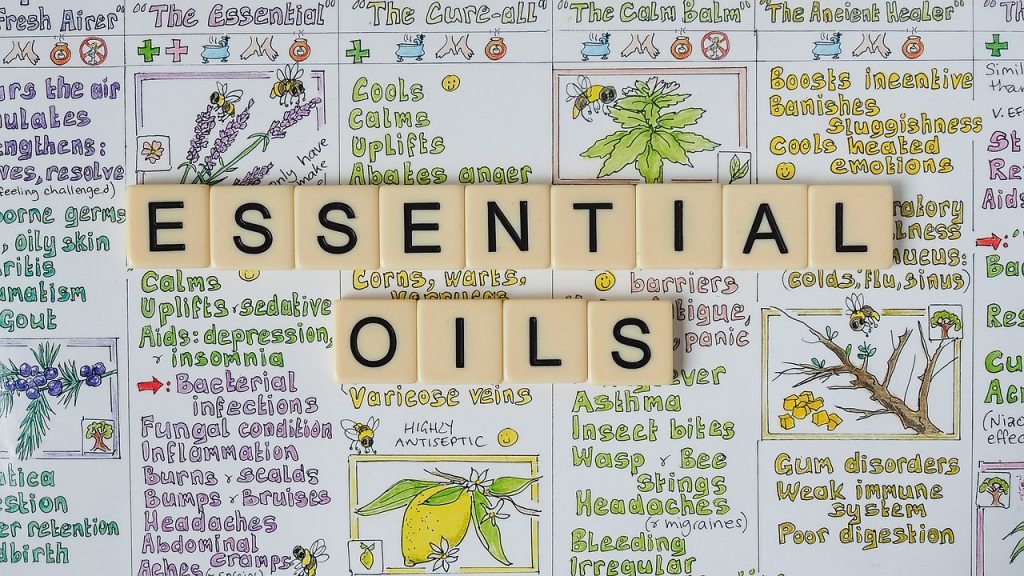Have you ever noticed how a particular scent can completely change your mood, sometimes in just an instant? For me, the smell of fresh bread immediately reminds me of being a young girl and going to my Nan’s house. Or blooming bushes of honeysuckle and jasmine can instantly give me feelings of comfort and joy. This is the power of scent in action and it’s just one of the many ways that essential oils can have a positive impact your health. Another way that essential oils can be used during perimenopause is for their ability to be able to restore hormonal balance, which makes them a powerful tool for women’s holistic care during their physical transition.
So, what exactly are essential oils? Also widely known as aromatherapy, essential oils are basically concentrated extracts from different parts of plants, including the petals, leaves, bark, rinds and roots, that capture their unique scents and properties. The oils are made using different extraction methods, such as water distillation and mechanical processing that expresses the oils out of citrus peels, resulting in potent oils that are packed with beneficial compounds — and smell divine. This is why so many people now use essential oils for healing, because they’re an easy-to-use solution for immediate relief, including for regulating hormonal imbalance.
During perimenopause, reducing your stress levels is crucial for maintaining good overall health and the scents from essential oils can play a significant role in this process. The olfactory bulb is a structure at the front of your brain that sits above the nasal cavity under the frontal lobe and receives neural input about the odours it detects from cells in the nasal cavity. These inputs are then processed and sent to other areas of the brain for further interpretation, which allows us to perceive and recognise different scents and links these smells to emotions and memories, given its close connection to the limbic system, which is responsible for your emotional processing. This connection also explains why certain smells can evoke strong emotions and influence hormone levels, including cortisol, the stress hormone.
While conventional medicine often relies on medications to deal with menopause, using essential oils is one of the ways that offers a natural alternative to enhance your overall wellbeing during this time. Because everyone’s different, they might not work for everyone, but in general when used correctly, they pose little risk and can become an invaluable part of your wellness toolkit for the hormonal imbalance that comes with menopause and is exacerbated by things like chronic stress, exposure to toxins, not eating organic food or lack of sleep, which can overwhelm your body and further affect hormone production and signalling. For instance, chronic stress leads to excessive cortisol production, which diverts resources from other hormones like oestrogen and progesterone.
8 Essential Oils for Hormonal Balance
So, maintaining a healthy lifestyle, reducing stress AND using essential oils can help to restore your hormonal balance and there are eight below that I consider to be the most effective for menopause and that I myself use regularly. The links to buy the essential oils that I personally use are grown organically and are free of pesticides and other harmful chemicals. When buying essential oils, you need to ensure that you purchase pure oils from reputable companies, because although you may find some at a cheaper price, they will contain additives or chemicals that could make your hormonal imbalances even worse. So, you definitely need to be mindful of what you’re purchasing.
1. Chamomile
Chamomile essential oil is an excellent natural remedy for managing menopause symptoms, because of its calming and anti-inflammatory properties. One of the most common challenges during menopause is disrupted sleep, due to anxiety and/or night sweats. Chamomile is well-known for its soothing effects on the nervous system, helping to alleviate anxiety and promote restful sleep. This essential oil’s anti-inflammatory properties can help ease muscle tension and discomfort, and its gentle, floral aroma aids in emotional balance, providing comfort during mood swings or feelings of irritability.
2. Clary Sage
Clary sage essential oil is known for its potential impact on hormones. Some studies, although small and often conducted on animals, suggest that it can reduce cortisol levels and increase 5-HTP, which is a precursor to melatonin, the hormone that regulates your sleep patterns. Clary sage also contains sclareol, a compound that helps address excess oestrogen in the body. Additionally, clary sage aromatherapy can relieve perimenopausal menstrual cramps and reduce blood pressure.
3. Frankincense
Frankincense is widely renowned for its ability to balance thyroid hormones T3 and T4, as well as reduce inflammation and cortisol levels. Many women also use frankincense to alleviate menstruation and menopausal symptoms, including pain, anxiety and mood swings. Using frankincense on your skin also helps to minimise fine lines and wrinkles. Frankincense essential oil is renowned for its rejuvenating effects on the skin, making it a popular choice for reducing the appearance of fine lines and wrinkles to promote a more youthful complexion. Its powerful astringent properties help tighten the skin, minimise pores and enhance its elasticity. You can add a few drops to a carrier oil or mix it into your usual facial moisturiser for more radiant skin.
4. Lavender
Lavender essential oil is well-researched for its calming effects on stress, depression and cortisol production. It can also be used to enhance deep, restorative sleep and alleviate irritation and mood swings. Lavender is adaptogenic, which means that it can help balance hormones by adapting to your body’s needs without side effects.
5. Peppermint
You may associate peppermint with toothpaste more than lifting your spirits, but this essential oil can help to stabilise mood-related hormones. It also helps alleviate menopausal symptoms and headaches linked to hormonal shifts. Studies have shown that peppermint oil can be as effective as paracetamol for pain relief.
6. Rosemary
Rosemary essential oil has the ability to help remove excess oestrogen from the body, aiding in healing hormonal imbalances. It also offers numerous benefits, including lowering cortisol, fighting cancer cells and improving memory. The oil’s effectiveness is attributed to its strong antioxidant properties.
7. Fennel
Fennel essential oil is a valuable ally for women experiencing menopause, thanks to its hormone-balancing properties. Rich in phytoestrogens, fennel can help alleviate symptoms like hot flashes, night sweats and mood swings by mimicking the effects of oestrogen in the body. This can be particularly beneficial during perimenopause, when our natural oestrogen levels start to decline. In addition, fennel essential oil is known for its ability to improve digestion and reduce bloating, which are also common menopausal discomforts. Its sweet, spicy aroma also promotes relaxation and emotional balance, which can be soothing during this transitional phase.
8. Ginger
Ginger essential oil is also gaining in popularity as a natural remedy for alleviating menopausal symptoms. Known for its warming and invigorating properties, ginger essential oil can help combat fatigue and enhance your mood, while its anti-inflammatory and antioxidant properties can also support your overall wellbeing by reducing the risk of chronic diseases that are often associated with aging. Ginger essential oil may also helps to alleviate digestive issues and nauseae.
As I mentioned above, it is imperative that you use essential oils that are manufactured from plants that have been grown without pesticides and other chemicals. They are potent products and so should be used with care, especially if you are going to use them topically — mixing a few drops with a carrier oil like olive, coconut, sweet almond or jojoba oil works best. You can also add a few drops to your moisturisers and lotions, add them to bath water or diffuse them in the air for inhalation. If you’re going to use them on your skin, it is best to test a small area to check for sensitivities at least 24 hours before you apply them widely.
Essential oils provide us with a natural and holistic approach to managing our hormonal imbalances during perimenopause. By integrating them into a healthy lifestyle, you can harness the power of scent to improve your mood, reduce stress and support your hormones. The benefits of these wonderful natural odours have been well-recognised in holistic health practices for years, so why not give these beauties a try to ramp up your perimenopausal health regime?
Love, Gaynor x





